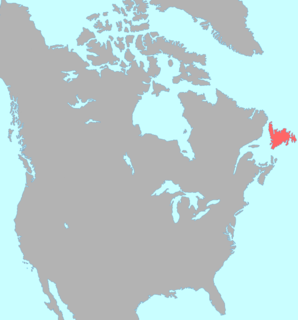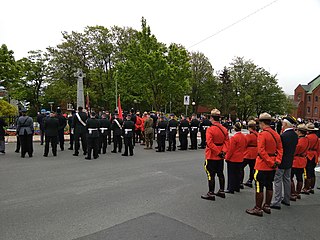 W
WThe Arts and Culture Centres are a system of six arts centres in the province of Newfoundland and Labrador, operated by the provincial government's Department of Tourism, Culture, Arts and Recreation (TCAR). Each has a least one stage for the performing arts; some also house an art gallery or exhibition area, a public library, and a swimming pool.
 W
WThe Beothuk were a group of indigenous people who lived on the island of Newfoundland.
 W
WA fish flake is a platform built on poles and spread with boughs for drying cod on the foreshores of fishing villages and small coastal towns in Newfoundland and Nordic countries. Spelling variations for fish flake in Newfoundland include flek, fleyke, fleake, flaik and fleack. The term's first recorded use in connection with fishing appeared in Richard Whitbourne's book Newfoundland. In Norway, a flake is known as a hjell.
 W
WNewfoundland French or Newfoundland Peninsular French, refers to the French spoken on the Port au Port Peninsula of Newfoundland. The francophones of the region can trace their origins to Continental French fishermen who settled in the late 1800s and early 1900s, rather than the Québécois. Some Acadians of the Maritimes also settled in the area. For this reason, Newfoundland French is most closely related to the Norman and Breton French of nearby St-Pierre-et-Miquelon. Today, heavy contact with Acadian French—and especially widespread bilingualism with Newfoundland English—have taken their toll, and the community is in decline.
 W
WL'Anse aux Meadows is an archaeological site first excavated in the 1960s of a Norse settlement dating to approximately 1,000 years ago. The site is located on the northernmost tip of the island of Newfoundland in the Canadian province of Newfoundland and Labrador.
 W
WThe London and Bristol Company came about in the early 17th century when English merchants had begun to express an interest in the Newfoundland fishery. Financed by a syndicate of investors John Guy, himself a Bristol merchant, visited Newfoundland in 1608 to locate a favourable site for a colony. Upon his return to England 40 people applied for incorporation as the Tresurer and the Companye of Adventurers and planter of the Cittye of london and Bristoll for the Collonye or plantacon in Newfoundland. The company was known as the London and Bristol Company or simply the Newfoundland Company.
 W
WMemorial Day has been observed annually since 1 July 1917, to recall the losses of approximately 700 soldiers of the 1st Newfoundland Regiment from the Dominion of Newfoundland at Beaumont-Hamel on the first day on the Somme during the First World War. Since the induction of Newfoundland into Canada in 1949, "Memorial Day" has been amalgamated to commemorate the sacrifices of members of the armed forces of the Canadian province Newfoundland and Labrador in times of war. It is observed concurrently with Canada's national holiday, Canada Day.
 W
WMummering, or mumming, is a Christmas-time house-visiting tradition practised in Newfoundland and Labrador, Ireland and parts of the United Kingdom.
 W
WThe Newfoundland Time Zone (NT) is a geographic region that keeps time by subtracting 3.5 hours from Coordinated Universal Time (UTC) during standard time, resulting in UTC−03:30; or subtracting 2.5 hours during daylight saving time. The clock time in this zone is based on the mean solar time of the meridian 52 degrees and 30 arcminutes west of the Greenwich Observatory. It is observed solely in the Canadian province of Newfoundland and Labrador. The Newfoundland Time Zone is the only active time zone with a half-hour offset from UTC in the Americas.
 W
WPoint Rosee, previously known as Stormy Point, is a headland near Codroy at the southwest end of the island of Newfoundland, on the Atlantic coast of Canada.
 W
WProtoGalaxy is a cross-genre video game for Microsoft Windows that was released on October 6, 2010. In the game's back-story, a species of powerful, unknown extraterrestrials enters the Milky Way with the intention of enslaving its inhabitants. The player characters must defend Earth from this alien threat and restore human civilization. ProtoGalaxy is a 2.5D game; the 2D playing field employs 3D graphics. ProtoGalaxy incorporates elements of a variety of gaming genres, such as adventure, arcade, shooter, puzzle, and role-playing genres.
 W
WA rodney or punt is a small Newfoundland wooden boat typically used by one man for hook and line fishing, for squid jigging, for travelling settlement to settlement, to shop, or to get out to their powered fishing boats. When towed behind a larger boat as a convenience in going from the larger boat to shore, a rodney was called a go-ashore.
 W
WSable Chief was a Newfoundland dog that served as the mascot of the Royal Newfoundland Regiment during World War I. He was presented officially on 1 Oct 1914, before troops left St. John's on the SS Florizel, by James R. Stick of the Royal Stores, Ltd, father of Leonard Stick, the first man to enlist in the regiment. Prior to his official presentation, the mascot was photographed at the Pleasantville training camp in Sept 1914 with Prime Minister Edward Patrick Morris (1859–1935), Governor Sir Walter Edward Davidson (1859–1923), Capt. William Hodgson Franklin, Capt. J. W. March, Capt. Cluny Macpherson (1879-1966), and other dignitaries.